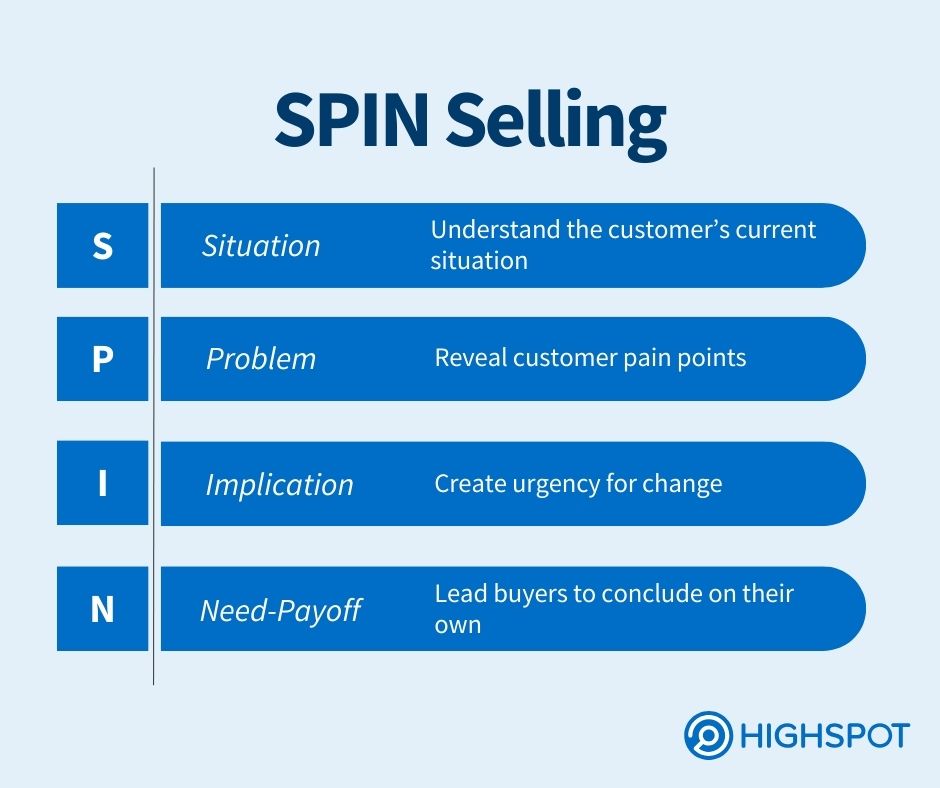Key Takeaways
- The approach helps sales reps build customer relationships using four types of questions
- The 4 types of questions consist of: Situation, Problem, Implication, Need-Payoff
- SPIN selling can enhance sales productivity by up to 17%
90% of B2B buyers don’t follow a linear sales funnel anymore. With more stakeholders involved, multiple communication channels, and changing economic conditions, it’s more important than ever to have a deeper understanding of buyers. This also means that traditional sales techniques emphasising product-driven solutions no longer work in today’s demands.
To meet the needs of modern B2B buyers, sales teams need to shift toward a customer-centric and value-driven approach. This is where SPIN Selling by Neil Rackham comes in. It focuses on listening and understanding customer needs through targeted questioning.
Are you ready to learn how Rackham’s SPIN selling guides your sales team to ask purpose-driven questions that open doors to new opportunities? Read this ultimate guide, which includes over 30 SPIN selling questions and practical selling techniques to elevate your sales strategy.
What Is SPIN Selling?
SPIN selling is a consultative sales method developed in the 1980s to close complex deals. The approach helps sales reps build customer relationships using four types of questions. SPIN stands for: situation, problem, implication, and need-payoff.
Mastering SPIN selling means integrating these conversational techniques into everyday sales calls to build lasting relationships and drive tangible outcomes. Rackham’s sales methodology emphasises creating value that persuades customers to commit. This selling process has proven effective across industries, particularly those with long sales cycles, many stakeholders, and complicated processes.
The Four Types of SPIN Selling Questions
Rackham and his team at Huthwaite studied 35,000 sales calls to identify what makes the top successful salespeople. They isolated queries from real-time sales conversations into four question types that form the SPIN acronym.

- Situation – Understand the customer’s current situation, such as business goals, processes, and other factors.
- Problem – Understand the issues and challenges the customer is facing, which your product or service could potentially address.
- Implication – Help the customer recognise the extent of their problems, creating a sense of urgency or need for a solution.
- Need-Payoff – Guide buyers to conclude on their own–seeing the value of solving the problem with your solution now rather than later.
The Four Stages of SPIN Selling
The SPIN selling methodology follows a structured approach through four buying stages. Each stage is designed to guide sales reps in managing conversations as the buyer’s journey progresses and integrates the four types of questions to facilitate targeted discussions. For instance, a discovery call might begin with SPIN situation questions to establish context. On the other hand, follow-up calls might dig into problem questions to identify challenges. Rackham reported that having a solid questioning strategy can increase your close rate by 20%.
Top sellers introduce their solutions later in the sales cycle, focusing first on the customer’s situation and the impact of their problems. This strategy encourages prospects to recognise their own need for a solution and often leads them to conclude that your offering is the best fit.
Here is how the four stages work:
- Opening or Preliminaries: Begin with light, open-ended Situation questions. The goal is to build rapport with potential clients. Focus on understanding their current situation and expressing genuine interest in their experiences and challenges. Try not to push features or products early in the conversation.
- Investigating: Focus on uncovering the lead’s specific pain points with Problem questions. This investigative phase is crucial for identifying underlying issues that your solutions can address. Balance the need to prompt and guide the conversation without overwhelming the prospect with interrogative questions.
- Demonstrating capability: Transition into Implication questions to explore consequences and highlight the need for your solution. Talk about the value of solving the problem. Once you’ve connected well with your prospect, they’re now open to hearing how your product or service can help them.
- Obtaining commitment: Encourage a small step forward with Need-Payoff questions. This could be a trial, follow-up meeting, or a final deal. This step guides the client to move forward to the next steps. At this point, it’s important for your sales team to reflect on what worked and what didn’t in each customer interaction to make future deals even better.
This structure keeps the conversation naturally progressing from understanding the prospect’s situation to securing their commitment, making every sales engagement meaningful.
37 SPIN Question Examples for Your Next Sales Call
Today’s buyers are more complex than ever before. To build the necessary relationships that further the sales process, sales reps must ask the right questions at the right time. The SPIN model provides structure to address buyer objections while avoiding an overwhelming interrogation.
Being prepared with purposeful questions facilitates a smoother sales process and improves outcomes. Let’s turn theory into practice and examine questions that fit the SPIN selling method category and stage.
Situation Questions
It’s common for sales professionals to prematurely focus on their product without understanding the prospect’s situation, often leading to a sales pitch that falls flat. Instead, sales reps should open with situation questions to gauge the customer’s current context, challenges, and how they think they compare to others. This helps you tailor follow-up questions and align your product or service with the prospect’s perceived or actual needs.
Here are some examples to establish context and understand the prospect’s current environment:
- Can you tell me about your role at your company?
- I was hoping you could walk me through an average day at your job.
- What is your approach to [use case]?
- Will you tell me about your current processes?
- What tools do you currently use?
- Why did you invest in these tools?
- How effective do you find these tools?
- How often do you use them?
- Who is responsible for [use case]?
- How much of the budget is assigned to [problem]?
- What is your top priority for the year?
- Why is this priority important to your business?
- Who owns the strategy for [priority]?
Problem Questions
Instead of pitching your product immediately, focus on understanding the prospect’s goals and the hurdles they face. Use this opportunity to help them recognise their own issues. Ask questions that explore what’s holding them back and what they aim to achieve.
Here are some examples to uncover specific challenges:
- How important is [priority] to your business?
- What challenges do you anticipate?
- What is your biggest day-to-day challenge?
- How easy is it to make progress against [priority]?
- Why does this approach work/not work for you?
- Does your current approach to [priority] ever fail?
- What happens if you’re not successful with [priority]?
- In a perfect world, what would your approach look like?
- Do you think [problem] can be solved?
- What’s stopping you from solving it?
Implication Questions
Initially, the problems may seem like minor inconveniences. Encourage the prospect to explore the consequences if the issues are not addressed. Actively listen and discuss the broader outcomes, emphasising the urgency of finding a solution. This part of the conversation is where you truly understand their needs while indirectly pitching your product’s features and benefits.
Here are some examples to help highlight the impact of the problems:
- Has the business ever missed a KPI due to your current approach? Why?
- What is the cost of your current approach?
- How much time does your current approach require?
- How would you distribute these resources differently if you didn’t have to use them on [problem]?
- What goal would you like to achieve that you currently can’t because of [problem]?
- How is [problem] impacting your work?
- How is [problem] impacting your team’s work?
- How is [problem] impacting your customers’ experience?
- Would resolving [problem] allow you to advance your career?
Need-Payoff Questions
It’s time to gauge the problem’s urgency and set the stage for closing. Encourage the prospect to articulate the value and benefits of a solution in their own words. As they do this, they’ll start to see the real value themselves, which can naturally lead to a decision. So, ask questions that help them think through what changes once the problem is solved—this can be a real eye-opener and a pivotal moment in the conversation.
Here are some examples to help move toward a purchasing decision:
- What would change if you did [approach] differently?
- How would it be easier to achieve [priority] with [solution]?
- Would your team get value from [solution]?
- How will solving the [problem] help you?
- What would achieving [priority] solve for your business?
Assessing Progress and Outcomes in SPIN Selling
Transactional sales calls move quickly and are highly impersonal. Sales reps often move through all stages in a single interaction. However, this approach is ineffective for larger sales deals with extended sales cycles. SPIN Selling introduces four distinct outcomes to track the progress of such deals:
- Advance: The buyer agrees to specific next steps, including a pricing review, a trial, or scheduling additional meetings with more decision-makers.
- Continuation: This less desirable outcome occurs when the buyer does not commit to any next steps.
- Order: The buyer commits to purchasing your product and signs a contract.
- No-Sale: The deal was rejected, and there are no plans for future engagement.
Use your customer relationship management (CRM) system to monitor and record these outcomes to gauge deal progress and track trends.
Tips and Best Practices to Get SPIN Selling Right
There are countless ways you can SPIN a sales call, but you’ll want to get a few best practices right, regardless of which questions you ultimately ask.
Ask Purposeful Questions
Use open-ended questions that encourage a more detailed response to avoid receiving simple “yes” or “no” answers. Actively listen to the buyer and validate their responses to maintain ongoing dialogue, and don’t overwhelm them with too many questions at once. Never ask questions just for the sake of asking.
Guide The Buying Process
Earn the buyer’s trust by anticipating their needs. Adjust your approach based on their unique circumstances and stage in the buying cycle. Offer relevant content, case studies, data, and support to nudge them toward making a decision or committing to the next steps.
Related Resource: 5 Best Practices to Engage the Modern Buyer
Leverage Social Selling
Use social media to research leads and to build and maintain relationships with potential clients. Engage with them on LinkedIn, share content that adds value to their interests, and gather intel into their business reputation, industry trends, and buying activities. Do this before your first sales interaction.
Make The Most of Technology
Adopt technology that will streamline and enhance your sales processes. Use CRM systems for managing customer data and interactions, analytics tools for tracking sales performance, sales enablement platforms and playbooks for engaging prospects, and virtual meeting platforms for facilitating remote interactions.
Handle Objections and Follow-up
Listen carefully to concerns, clarify misunderstandings, and offer solutions that align with the prospect’s objectives. Be prepared to address common objections, such as price and time investment. Ensure you follow up promptly to maintain momentum.
Master the SPIN Selling Skills
SPIN selling requires essential sales skills beyond just asking the right questions. Commit to mastering this consultative selling technique by following these four golden rules:
- Focus on a single skill: If you want to master complex skills, practise one thing at a time, nail it, and then move on.
- Choose low-risk calls for practising: Practice makes perfect, but not all opportunities are equal. Opt for low-stakes practice sessions where you can experiment and refine your skills without compromising a sales deal.
- Use the behaviour frequently: The more you use a behaviour, the more instinctive it becomes. Over time, your performance quality will improve.
- Try at least three times: First attempts are rarely flawless. This holds true for SPIN selling. Give your chosen behaviour a fair shot by trying at least three times before passing judgement on its effectiveness.
SPIN Sales Training
Specialised SPIN sales training programme, offered by organisations like Huthwaite International, sharpens the unique skills needed to ensure successful sales.
The hands-on training uses interactive activities that mirror real-world sales situations, helping sales reps build confidence and make quick, impactful decisions. It covers skills such as knowing when to shift tactics, analysing why sales fail, and incorporating SPIN sales techniques across different sales channels. This training also emphasises the importance of adapting to current market trends, spotting new sales opportunities, and maintaining a solid strategy even when sales must be conducted virtually.
Integrating this programme into your sales training software further enhances its effectiveness by providing a scalable and flexible platform for continuous learning and practice. Sales teams can track their progress, receive personalised feedback, and engage in realistic simulations that reinforce key SPIN selling principles.
By honing the SPIN sales methodology, your team can establish routine and rigour in their sales strategy, ultimately boosting sales team confidence and sales success. Remember, SPIN selling can enhance sales productivity by up to 17%.
While there’s no one-size-fits-all sales methodology, SPIN Selling is a great example of how a targeted approach can work wonders when applied effectively. Watch the video to explore how to choose the right methodology—or even combine several—to suit your team.
Ace your SPIN Selling Strategy with Highspot
A product’s features alone are often not enough to seal the deal. SPIN selling provides a winning framework if you’re ready to tackle major sales with powerful closing techniques. It emphasises patience and a genuine interest in the customer’s needs while steering away from traditional transaction-based sales strategy.
However, turning theory into practice isn’t always easy. This is where proper training and tools become indispensable, transforming a good sales force into a great one.
Integrating Highspot into your SPIN strategy will give your sales force the necessary resources to excel. With the right approach and tools, your team will be well-equipped to turn SPIN selling theory into a consistent, successful habit.
Request a demo today!




